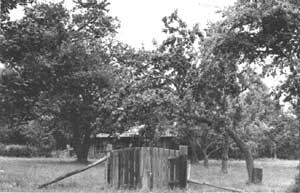|
EBEY'S LANDING
Ebey's Landing National Historical Reserve Reading the Cultural Landscape |

|
PREFACE

This report represents the fourth major opportunity for the Cultural Resources Division to engage and explore the significant resources and complex values of Ebey's Landing National Historical Reserve.
The involvement of this division began in the summer of 1983 with a team of five individuals living on the reserve and conducting an inventory of every pre-1940 building, as well as the entire 17,400 acres of landscape that make up the reserve. The inventory as a whole sought to explore and record, not only individual landscape features and isolated structures, but the relationship between the built and natural environments, which forms the underlying fabric in a cultural landscape.
The product from that summer was more than a three-volume set of inventory cards. Over the course of fourteen weeks, there was a growing awareness among those directly involved, that there existed a significant and historic relationship between the resources of the reserve and the evolving community values that had shaped this place over time. It was an awareness that came slowly . . . that the landscape we were walking over and cataloguing that summer was more than a pleasant rural scene with some old buildings. Indeed, we began to see the landscape as a reflection of cultural trends and historic events, that had made a physical impression like a giant footprint on the land itself. Many of the structures, fence lines, roads, and land uses had not only remained the same for over a hundred years, but were commonly used in the everyday workings of the community.
In an effort to explore the value and significance of these resources a second report was underway by the fall of that year. In The Land, The People, The Place, an attempt was made to describe and bring together the facts, feelings and values of Ebey's Landing. It was written for the residents of the reserve but it served a much greater audience. Over the next few months we heard from other parts of the country, how other rural based communities were asking similar questions about the relative meanings and directions for protection of such resources.
Ultimately it is the human caring about a place that determines its vitality. There was no shortage of caring on the reserve. In response to community interest and in order to assist in providing tools for preservation of the resources a third report, Design Considerations for Historic Properties, was completed during the summer of 1984. A sensitive text and highly illustrated format helped enforce the idea that it is not only the more elaborate homes and commercial buildings that are important to the reserve, but also the simpler homes, farms and complexes, public buildings and less elaborate commercial structures. Understanding the whole place and providing guidelines for protecting buildings in a landscape context through reasonable preservation measures was a valuable step, that in a sense, led to this final report.
This report, Reading the Cultural Landscape, seeks to identify, more specifically, the landscape resources on the reserve. It is written primarily for the trust board of Ebey's Landing and suggests guidelines and principles for conservation of significant historic and cultural landscape elements.
Altogether these four projects are tools that help to identify, evaluate and guide preservation efforts for the combined resources of Ebey's Landing National Historical Reserve. Because of the complex nature of the reserve, management of these resources must be a cooperative effort of the community and local, state and federal groups, seeking preservation of a quality and sense of place, as well as a physical landscape and related structures.
Development of reports done by this division over the last two years has been the product of many people. A great deal of credit goes to Reed Jarvis, Project Manager of Ebey's Landing, who not only provided the opportunities, but had the foresight to understand the work that needed to be done, and had the patience to see it through. An appreciation also to Dr. T. Allan Comp, Chief of the division of Cultural Resources, who has guided this work over two years and encouraged an intellectual rigor and professional enthusiasm in every aspect of these projects.
Professor Robert Melnick from the University of Oregon generously shared his ideas and knowledge on the subject, as well as expertise on this report and other projects over the last two years. Dr. Jennifer L. Specker from the University of Rhode Island gave an enormous amount of time reviewing material and editing various texts.
In addition, over the last three years Kent Bush, Laurin Huffman, Jim Thomson, Stephanie Toothman, Jane Evans and Hank Florence all contributed generously to the material content and form of these reports. Their support, criticisms and suggestions made the work both useful and creative.
Finally a special appreciation to Gretchen Luxenberg, architectural historian, who managed to teach this author something about the individual character and magical personality of structures in the landscape. Her sensitivity, perception and technical skill has made looking, at landscapes an environmental education and an enriching experience.
It is hoped these four documents collectively, can contribute to an understanding of the resources and can assist those responsible in making appropriate management decisions regarding the future of Ebey's Landing National Historical Reserve.
"Each living pattern resolves some system of forces, or allows them to resolve themselves. Each pattern creates an organization which maintains that portion of the world in balance."
Christopher Alexander
Pattern Language
Landscape Development and Settlement Patterns | Looking at Landscapes | Reading the Landscape
Preservation Principles | Appendix | Bibliography
rcl/rcl1.htm
Last Updated: 07-Dec-2015